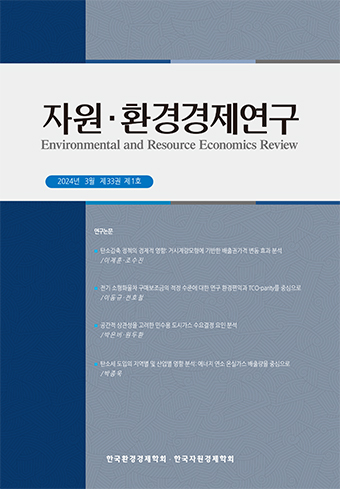Research Paper
Abstract
References
Information
As variable renewable sources rapidly increase due to the Energy Transition plan, integration cost of renewable sources to the power system is rising sharply. The increase in variable renewable energy reduces the capacity factor of existing traditional power capacity, and this undermines the efficiency of the overall power supply, and demand resources are drawing attention as a solution. In this study, we analyzed how much electric vehicle demand resouces, which has great potential among other demand resources, can reduce power supply costs if it is used as a flexible resource for renewable generation. As a methodology, a stochastic form of power system optimization model that can effectively reflect the volatile characteristics of renewable generation is used to analyze the cost induced by renewable energy and the benefits offered by electric vehicle demand resources. The result shows that virtual power plant-based direct control method has higher benefits than the time-of-use tariff, and the higher the proportion of renewable energy is in the power system, the higher the benefits of electric vehicle demand resources are. The net benefit after considering commission fee for aggregators and battery wear-and-tear costs was estimated as 67% to 85% of monthly average fuel cost under virtual power plant with V2G capability, and this shows that a sufficient incentive for market participation can be offered when a rate system is applied in which these net benefits of demand resources are effectively distributed to consumers.
에너지전환 정책의 가속화로 변동성 재생에너지가 가파르게 증가하면서 계통수용비용이 빠르게 상승하고 있다. 변동성 재생에너지 증가는 기존 전통적 발전자원의 이용률을 하락시켜서 전력공급에 비효율성을 가중시키는데 이에 대한 해결책으로 수요자원이 주목받고 있다. 본 연구에서는 수요자원 중 큰 잠재력을 가지고 있는 전기차 수요가 재생발전에 대한 유연성 자원으로 활용될 경우 전력공급비용을 얼마나 경감시킬 수 있는지 9차 전력수급계획을 반영하여 분석하였다. 분석모형으로 재생발전의 확률적 특성을 사실적으로 반영할 수 있는 확률적 전력시스템 최적화 모형을 적용해서 재생에너지가 유발하는 비용과 전기차 수요자원의 편익을 분석하였다. 분석결과 계시별 요금제보다 가상발전소 기반의 직접제어방식이 편익이 더 높고, 발전구성에서 재생에너지의 비중이 높아질수록 편익이 더 높아지는 것으로 나타났다. 전기차 수요자원의 구현비용인 중개사업자 수수료와 배터리마모비용을 고려한 순편익 추정결과, 충방전이 가능한 가상발전소 방식의 경우 월평균 운행비용의 67~85% 수준으로 나타났다. 이러한 수요자원 순편익이 소비자에게 효과적으로 분배되는 요금체계가 적용될 경우 시장참여유인이 높을 것으로 추정된다.
- 교통안전공단, 「2014년 자동차 운행기록분석」, 2014.
- 대한민국정부, 「미래자동차 산업 발전 전략-2030년 국가 로드맵, 관계부처 합동」, 2019.
- 산업통상자원부, 「제3차 에너지기본계획」, 2019.
- 산업통상자원부, 「제8차 전력수급기본계획」, 2017.
- 산업통상자원부, 「제9차 전력수급기본계획」, 2020.
- 손상훈, 「제주 전기차 일평균 주행거리: 전기차 및 충전기 이용실태와 향후 정책 과제」, 2019.
- 전력거래소, 「전력거래통계시스템(EPSIS)」, 2020.
- 전우영, “확률적 전력계통망 최적화모형 구축 연구”, KEEI 기본연구보고서, 2015.
- 제주연구원, 「전기차 동향 및 통계 월간 리포트」, 2018.
- 현대차그룹, 「전기차 충전요금, 얼마나 들까?, 현대차그룹 사내기사」, 2019.
- 환경부, 「2050 장기저탄소발전전략」, 2020.
- 환경부, 「실구매자 이용실태 조사 분석을 통한 전기차 보급 활성화 연구 용역」, 2017.
- Bruninx, K., E. Delarue, H. Ergun, K. May, K. Bergh, and D. Hertem, Determining the impact of renewable energy on balancing costs, back up costs, grid costs and subsidies, KU Leuven, 2016.
- Dubey, A., S. Santoso, M. Cloud, and M. Waclawiak, “Determining Time-of-Use Schedules for Electric Vehicle Loads: A Practical Perspective,” IEEE Power and Energy Technology Systems Journal, Vol. 2, No. 1, 2015, pp. 12~20.10.1109/JPETS.2015.2405069
- IRENA, Electric-Vehicle Smart Charging Innovation Landscape Brief, 2019.
- Jeon, W. and J. Y. Mo, “The True Economic Value of Supply-Side Energy Storage in the Smart Grid Environment - The case of Korea,” Energy Policy, Vol. 121, 2018, pp. 101~111.10.1016/j.enpol.2018.05.071
- Jeon, W., A. J. Lamadrid, J. Y. Mo, and T. Mount, “Using Deferrable Demand in a Smart Grid to Reduce the Cost of Electricity for Customers,” Journal of Regulatory Economics, Vol. 47, No. 3, 2015, pp. 239~272.10.1007/s11149-015-9268-0
- Lee, J., J. Lee, and Y. Wi, “Impact of Revised Time of Use Tariff on Variable Renewable Energy Curtailment on Jeju Island,” Electronics, 2021.10, 135p.10.3390/electronics10020135
- NEA, Nuclear Energy and Renewables: System Effects in Low-carbon Electricity Systems, 2012.
- Tuohy, A. and M. O’Malley, “Pumped storage in systems with very high wind penetration,” Energy Policy, 2011, 39p.10.1016/j.enpol.2011.01.026
- Ueckerdt, F., L. Hirth, G. Luderer, and O. Edenhofer, “System LCOE: What are the costs of variable renewables?,” Energy, Vol. 63, 2013, pp. 61~75.10.1016/j.energy.2013.10.072
- Zamani, A. G., A. Zakariazadeh, and S. Jadid, “Day-ahead resource scheduling of a renewable energy based virtual power plant,” Applied Energy, 2016, 169p.10.1016/j.apenergy.2016.02.011
- Zimmerman, R. D. and C. E. Murillo-Sanchez, Multi-Period SuperOPF Problem Formulation, 2013.
- Zimmerman, R. D., C. E. Murillo-Sanchez, and R. J. Thomas, “Matpower: Steady-State Operations, Planning and Analysis Tools for Power Systems Research and Education,” IEEE Transactions on Power Systems, Vol. 26, No. 1, 2011, pp. 12~19.10.1109/TPWRS.2010.2051168
- Publisher :Environmental and Resource Economics Review
- Publisher(Ko) :자원 · 환경경제연구
- Journal Title :자원·환경경제연구
- Journal Title(Ko) :Environmental and Resource Economics Review
- Volume : 30
- No :2
- Pages :237-268
- DOI :https://doi.org/10.15266/KEREA.2021.30.2.237



 자원·환경경제연구
자원·환경경제연구






